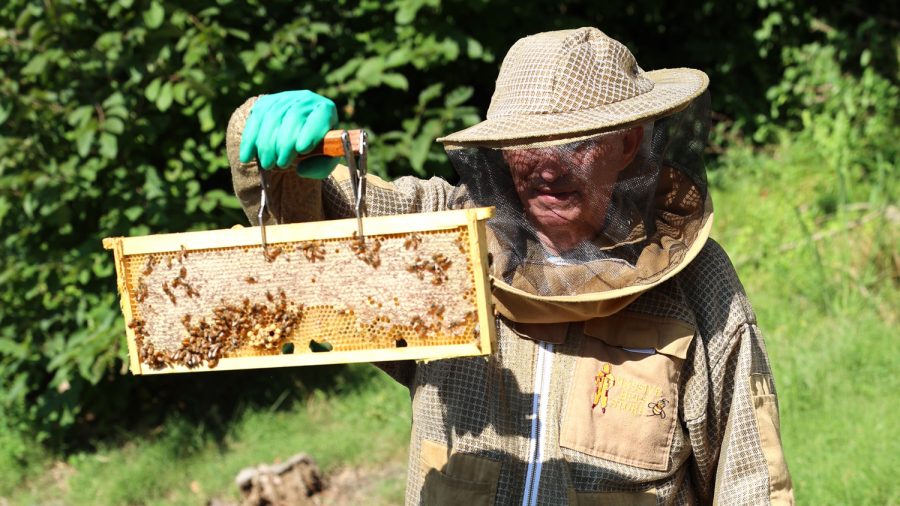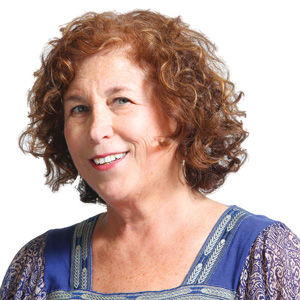Buzz-worthy project at United Hebrew brings sweet rewards
Published August 26, 2021
I’ve bungee jumped out of a hot air balloon and flown with the Blue Angels in a F-18. Granted, I was half my current age and didn’t have any children, but I took to those assignments — yes, both were work-related — in George Plimpton-esque fashion, willing to throw myself into the path of danger, if need be, for the good of lady journalism.
On Sunday, however, when Lonnie Grosman offered to have me suit up and join him while he tended to thousands of honeybees living in three hives near United Hebrew Congregation, I politely declined. All I could think of was that scene in 1991’s “My Girl,” when Thomas J. Sennett (MaCaulay Caulkin) tries to find Vada’s mood ring and gets swarmed by thousands of bees. In case you forgot, the result was not good.
“Initially, when bees come out, they are intimidating, but they are really not interested in you,” said Grosman, 66, who has been a beekeeper for five years. He notes that bees can be attracted to certain scents, like perfume and sweet-smelling sunscreen, as well as sugary products and dark colors.
ADVERTISEMENT
“They’ve got a great sense of smell and sight,” he said, adding that the worst thing you can do is try to swat them away. Much better to back off calmly, walking in a straight line.
Grosman, who is a member of UH, got involved with beekeeping as a way to battle his allergies. The thinking behind this was that since certain pollens in his backyard caused his allergies to flare, eating pollen from his own backyard could help desensitize him.
“Bees make honey by collecting pollen from plants and flowers in your backyard. The honey has natural antihistamines that can help your body adjust to seasonal allergies,” Grosman said, adding that some scientific opinions support this theory while others do not.
So, has eating honey from his backyard helped alleviate his allergies?
“Yes, though they are not gone completely,” he said.
ADVERTISEMENT
Regardless, Grosman seems to delight in beekeeping, and is more than willing to share what he has learned and help others get started. Rabbi Brigitte Rosenberg of UH told me how she and some family members got to observe Grosman, a retired senior mechanical estimator at CRB builders/engineering, and his wife, Sue, harvest the honey from their backyard hives several years ago. The process made an indelible impression on Rosenberg’s husband, Lee, who is director of secondary education and engagement at UH.
“He said, ‘What if we had hives at UH?’ ” Rabbi Rosenberg recalled. “Lonnie was like, ‘Sure. I’d be glad to help.’ ”
The rabbi said deciding whether to host beehives at the synagogue was “a very big conversation.”
“People don’t know enough about bees and their importance and were worried because we have a preschool and people in the parking lot and they could get stung,” said Rosenberg, who has suited up to join Grosman and the bees — and happily reported she did not get stung. “Ultimately, our board decided that for educational purposes it was a cool idea, so we gave Lonnie the green light.”
An untold number of bees now reside in one of three hives in a woodsy area above UH’s front parking lot, more than 20 feet from any parking spot. In the hour that Grosman, Rosenberg and I stood on the parking lot about 25 feet away from the hives, not one bee flew by us. And no bees bothered photographer Bill Motchan when he approached the hives to take pictures, though Grosman instructed him as to how close he could safely get.
Earlier this summer, Grosman constructed the UH beehive boxes out of pine wood and purchased a bee package of sorts for the largest of the three hives. Costing $165, the package came in a screened cage with three pounds of bees, including a queen (she is the egg layer – without her, no more bees), which he put it in the back seat of his car and drove to the synagogue. The other hives came from swarms that Grosman collected.
“My job is to ensure they have enough room to make the wax foundation (honeycomb) on the frames, which are placed inside the hive boxes that he built, to fill with honey,” Grosman said.
“I need to stay a step ahead of them, so they have enough room to build out the frames.”
The larger hive produced about three gallons of honey when it was recently harvested, a process that included the synagogue’s preschool campers, Rosenberg and Grosman said.
The youngsters got a chance to spin the centrifuge — centrifugal force draws the honey out of combs on the frames and into a bucket underneath — as well as sample the fresh honey and chew on a piece of the honeycomb.
After Rosenberg posted about the process on social media, several congregants expressed an interest in learning more. The synagogue now has a waiting list of people wanting to accompany Grosman as he tends to the bees.
“It’s a rewarding hobby,” he said, adding that his wife helps him harvest the honey and serves as accountant, letting him know when he has spent too much money on honey jars and equipment.
“You’re not trying to change Mother Nature, you’re just working with her and working with the bees,” Grosman continued. “Trying to keep up with them is sometimes really tough.”
















